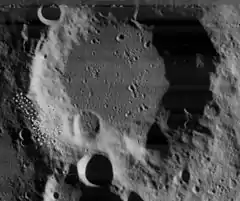Manzinus (crater)
Manzinus is a lunar impact crater that is located in the southern region of the Moon's near side. It lies less than one crater diameter to the south-southwest of the crater Mutus, and to the northwest of Boguslawsky. The latter is a crater with nearly the same dimension and a comparable appearance to Manzinus.
 Lunar Orbiter 4 image with north at top. (Group of dots in lower left is blemish on original image) | |
| Coordinates | 67.7°S 26.8°E |
|---|---|
| Diameter | 98 km |
| Depth | 3.8 km |
| Colongitude | 337° at sunrise |
| Eponym | Carlo A. Manzini |
The outer rim of Manzinus is worn, eroded, and somewhat irregular. The outer rim to the north-northeast is joined to the smaller Manzinus R, and the crest along that side is lower and forms a saddle. There is a cluster of small craters along the southern side that partly overlap each other, consisting of the craters D, E, G, and N listed in the table below. The heavily eroded satellite crater Manzinus A lies along the southeastern inner wall. Similarly the small crater Manzinus S lies along the northern inner wall, and the cup-shaped Manzinus J overlies the northwest rim.
The interior surface has been resurfaced in the past, and now forms a level, featureless plain that is marked only by a few tiny craterlets. The floor has the same albedo as the surrounding terrain.
India's Chandrayaan-3 mission successfully landed near Manzinus U at 69.37 degrees south latitude and 32.35 degrees east longitude
Satellite craters
By convention these features are identified on lunar maps by placing the letter on the side of the crater midpoint that is closest to Manzinus.
| Manzinus | Latitude | Longitude | Diameter |
|---|---|---|---|
| A | 68.4° S | 27.5° E | 20 km |
| B | 63.7° S | 21.1° E | 28 km |
| C | 70.1° S | 22.1° E | 25 km |
| D | 69.6° S | 24.7° E | 34 km |
| E | 68.9° S | 25.4° E | 18 km |
| F | 63.9° S | 19.7° E | 18 km |
| G | 69.6° S | 26.0° E | 16 km |
| H | 68.6° S | 19.2° E | 13 km |
| J | 66.3° S | 23.5° E | 12 km |
| K | 63.3° S | 20.3° E | 12 km |
| L | 64.4° S | 22.7° E | 20 km |
| M | 63.4° S | 22.8° E | 6 km |
| N | 70.2° S | 28.8° E | 14 km |
| O | 64.9° S | 25.0° E | 5 km |
| P | 67.8° S | 29.4° E | 6 km |
| R | 65.9° S | 30.0° E | 16 km |
| S | 66.4° S | 27.3° E | 11 km |
| T | 67.5° S | 32.9° E | 21 km |
| U | 68.6° S | 34.5° E | 21 km |
References
- Andersson, L. E.; Whitaker, E. A. (1982). NASA Catalogue of Lunar Nomenclature. NASA RP-1097.
- Blue, Jennifer (July 25, 2007). "Gazetteer of Planetary Nomenclature". USGS. Retrieved 2007-08-05.
- Bussey, B.; Spudis, P. (2004). The Clementine Atlas of the Moon. New York: Cambridge University Press. ISBN 978-0-521-81528-4.
- Cocks, Elijah E.; Cocks, Josiah C. (1995). Who's Who on the Moon: A Biographical Dictionary of Lunar Nomenclature. Tudor Publishers. ISBN 978-0-936389-27-1.
- McDowell, Jonathan (July 15, 2007). "Lunar Nomenclature". Jonathan's Space Report. Retrieved 2007-10-24.
- Menzel, D. H.; Minnaert, M.; Levin, B.; Dollfus, A.; Bell, B. (1971). "Report on Lunar Nomenclature by the Working Group of Commission 17 of the IAU". Space Science Reviews. 12 (2): 136–186. Bibcode:1971SSRv...12..136M. doi:10.1007/BF00171763. S2CID 122125855.
- Moore, Patrick (2001). On the Moon. Sterling Publishing Co. ISBN 978-0-304-35469-6.
- Price, Fred W. (1988). The Moon Observer's Handbook. Cambridge University Press. ISBN 978-0-521-33500-3.
- Rükl, Antonín (1990). Atlas of the Moon. Kalmbach Books. ISBN 978-0-913135-17-4.
- Webb, Rev. T. W. (1962). Celestial Objects for Common Telescopes (6th revised ed.). Dover. ISBN 978-0-486-20917-3.
- Whitaker, Ewen A. (1999). Mapping and Naming the Moon. Cambridge University Press. ISBN 978-0-521-62248-6.
- Wlasuk, Peter T. (2000). Observing the Moon. Springer. ISBN 978-1-85233-193-1.